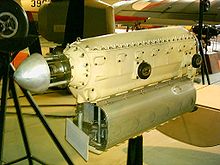Walter Minor
The Walter Minor was a piston aircraft engine for general aviation from the Czech manufacturer Walter Engines as The OHV engine was manufactured as a four-cylinder Walter Minor 4 , as a six-cylinder Walter Minor 6 and as a twelve-cylinder Walter Minor 12 and was widely used. While the production of the four-cylinder version was stopped in 1960 in favor of the successor Walter M332 , the production of the Minor 6-III continued at least until 1972, when it was built into the first copies of the Zlín Z-526 ; it was then replaced by the Walter M337 .
development
The development of the engine began in 1929. Series production of the engines began in 1930, the main design feature of which was the hanging cylinder with air cooling. The steel cylinders were turned together with the solid material cooling fins. The cylinder sliding surfaces were nitrided. The cylinder heads, cast from an aluminum alloy, had, in addition to two bores for the spark plugs, an inlet and an outlet valve made of steel, which were controlled via bumpers and rocker arms. The cylinders with the cylinder heads were each attached to the crankcase with four stud bolts. The aluminum pistons had three compression rings and one oil control ring. The connecting rods had a double-T profile and were made of polished aluminum. The connecting rod feet were split and had a bronze bearing in a steel shell. The forged crankshaft, machined on all sides, consisted of a chrome-vanadium steel alloy and was supported five or seven times in bronze plain bearings. The propeller thrust was absorbed by a radial ball bearing in the front part of the crankcase. This was designed in three parts and consisted of the actual crankcase as well as an upper and a front cover, all of which were made of a heat-hardened magnesium alloy. The crankshaft ran in it and on the left-hand side the camshaft driven by spur gears. The carburetor developed by Walter himself had a manual mixture regulation, a cold start device and an acceleration pump and was suitable for aerobatics, which included a special nozzle for inverted flight. The Minor 6-III had two carburetors. The supply was ensured by a membrane fuel pump. Two fully shielded Scintilla systems with automatic ignition timing were used for ignition. The lubrication was carried out by a dry sump circulation system, which was provided by a gear pump with suction and pressure stage at the rear of the crankshaft. The lubrication could be modified for aerobatics. The propeller was driven directly.
Two engine mounts were used to attach it to the airframe , with two suspension points on each side. The engine was started either by a manual or an electric starter.
The Minor 4-III formed the drive for the last version of the Bücker Bü 181 built under the designation Zlín Z-381, several of which were approved in Germany after 1955.
Technical specifications
| Parameter | Minor 4-III | Minor 6-III | Minor 12-I MR |
|---|---|---|---|
| Starting power | 105 hp at 2500 min -1 | 160 hp at 2500 min -1 | 385 hp at 2900 min -1 |
| Travel service | 80 hp at 2300 min -1 | 125 hp at 2300 min -1 | k. A. |
| Displacement | 3.98 l | 5.97 l | 11.95 l |
| Hub | 115 mm | 115 mm | 115 mm |
| drilling | 105 mm | 105 mm | 105 mm |
| compression | 6.0: 1 | 6.0: 1 | 6.0: 1 |
| length | 1032 mm | 1250 mm | k. A. |
| width | 399 mm | 445 mm | 510 mm |
| height | 632 mm | 639 mm | 800 mm |
| Weight | 90.3 kg | 126.8 kg | 325 kg |
literature
- Werner von Langsdorff : Handbook of aviation . Born in 1939. 2nd, unchanged edition. J. F. Lehmann, Munich 1937, p. 532/533 and 562 .
- Heinz A. F. Schmidt: Aircraft engines of socialist countries . In: Flieger-Jahrbuch 1971 . Transpress , Berlin 1970, p. 104 .

